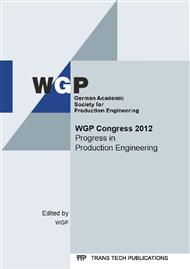[1]
Adam, H., Osbur, B., Patberg, L., Grüneklee, A., Flöth, T., Hinz, M., 2005: NewSteelBody - Auto body weight reduction with steel. In: Aluminium International Today, Vol. 17, No. 1, pp.42-44.
Google Scholar
[2]
Merklein, M., Kaupper, M., 2009: Manufacturing of Innovative Car Seat Components by Forming of Advanced High Strength Steels - Fundamental Research and Application. In: Key Engineering Materials, Vol. 410-411, pp.3-11.
DOI: 10.4028/www.scientific.net/kem.410-411.3
Google Scholar
[3]
Saito, Y., Tsuji, N., Utsunomiya, H., Sakai, T., Hong, R.G., 1998: Ultra-Fine Grained Bulk Aluminum Produced by Accumulative Roll-Bonding (ARB) Process. In: Scripta Materialia, Vol. 39, No. 9, pp.1221-1227.
DOI: 10.1016/s1359-6462(98)00302-9
Google Scholar
[4]
Vollertsen, F., Lange, K., 1998: Enhancement of drawability by local heat treatment. CIRP Annals, Vol. 47, No. 1, pp.181-184.
DOI: 10.1016/s0007-8506(07)62813-3
Google Scholar
[5]
Merklein, M., Vogt, U., 2009: Principles for the Heat Treatment Layout of Ultrafine-Grain Aluminium Blanks with Locally Adapted Mechanical Properties. In: Dimitrov, D. (Edtr. ): Proceedings of the COMA 2010, pp.135-140.
Google Scholar
[6]
Hausöl, T., Schmidt, C.W., Maier, V., Böhm, W., Nguyen, H., Merklein, M., Höppel, H.W., Göken, M., 2012: Formability of ultrafine-grained AA6016 sheets processed by accumulative roll bonding. In: Key Engineering Materials, Vol. 504-506, pp.575-580.
DOI: 10.4028/www.scientific.net/kem.504-506.575
Google Scholar
[7]
Topic, I., 2009: Ultrafine-grained metal sheets produced using the accumulative roll bonding process for light-weight structures. PhD-thesis, Erlangen, Germany.
Google Scholar
[8]
Tsuji, N., Saito, Y., Utsunomiya, H., Tanigawa, S., 1999: Ultra-Fine Grained Bulk Steel Produced by Accumulative Roll-Bonding (ARB) Process. In: Scripta Materialia, Vol. 40, No. 7, pp.795-800.
DOI: 10.1016/s1359-6462(99)00015-9
Google Scholar
[9]
Hausöl, T., Höppel, H.W., Göken, M., 2010: Microstructure and Mechanical Properties of Accumulative Roll Bonded AA6014/AA5754 Aluminium Laminates. In: Materials Science Forum, Vol. 667-669, pp.217-222.
DOI: 10.4028/www.scientific.net/msf.667-669.217
Google Scholar
[10]
Vaidyanath, L. R., Nicholas, M. G., Milner, D. R., 1959: Pressure Welding by Rolling. In: British Welding Journal, Vol. 6, pp.13-28.
Google Scholar
[11]
May, J., Höppel, H.W., Göken, M., 2005: Strain rate sensitivity of ultrafine-grained aluminium processed by severe plastic deformation. In: Scripta Materialia, Vol. 53, No. 2, pp.189-194.
DOI: 10.1016/j.scriptamat.2005.03.043
Google Scholar
[12]
Vogt, U., 2009: Seriennahe Auslegung von Aluminium Tailored Heat Treated Blanks. PhD-thesis, Meisenbach Verlag Bamberg, Germany.
Google Scholar
[13]
Hofmann, A., 2002: Erweiterung der Formgebungsgrenzen beim Umformen von Aluminiumwerkstoffen durch den Einsatz prozessangepasster Platinen. PhD-thesis, Meisenbach Verlag, Bamberg, Germany.
Google Scholar
[14]
Gese, H., Keller, S., Yeliseyev, V., Dell, H., 2007: Ermittlung von Fließwiderstandskurven bei großen Formänderungen für die Blechumformsimulation. In: Frenz., H. (Edtr. ): Kennwertermittlung für die Praxis. Wiley-VCH Verlag, Weinheim, Germany.
DOI: 10.1002/9783527610310.ch32
Google Scholar
[15]
Kessler, L., Borsutzki, M., Gerlach, J., Schaumann, T. W., 2005: Ermittlung und Anwendung von Werkstoffdaten für die Unterstützung der numerischen Bauteilentwicklung. In: Fünftes Industriekolloquium, SFB 362 Fertigen in Feinblech, pp.67-76.
Google Scholar
[16]
Reyes, A., Hopperstad, O. S., Lademo, O. -G., Langseth, M., 2006: Modeling of textured aluminum alloys used in a bumper system: Material tests and characterization. In: Computational Materials Science, Vol. 37, No. 3, pp.246-268.
DOI: 10.1016/j.commatsci.2005.07.001
Google Scholar
[17]
Herzig, N., Abdel-Malek, S., Meyer, L. W., 2010: Experimentelle Ermittlung und Modellierung dynamischer Fließortkurven an Blechwerkstoffen. In: Proc. of the 9th LS-DYNA forum, pp.29-40.
Google Scholar
[18]
Merklein, M., 2006: Charakterisierung von Blechwerkstoffen für den Leichtbau. PhD-thesis, Meisenbach Verlag, Bamberg, Germany.
Google Scholar
[19]
Merklein, M., Biasutti, M., Nguyen, H., Böhm, W., 2011: Flow Behaviour of Advanced Aluminium Materials. In: Hirt, G.; Tekkaya, E.A. (Edtr. ): Steel research international: Special Edition: 10th International Conference on Technology of Plasticity, Wiley-VCH Verlag, Weinheim, Germany, pp.1066-1071.
Google Scholar
[20]
Hill, R., 1948: A theory of the yielding and plastic flow of anisotropic metals. In: Proceedings of the Royal Society of London, 193A, pp.281-297.
Google Scholar
[21]
Hill, R., 1990: Constitutive modeling of orthotropic plasticity in sheet metals. In: Journal of the Mechanics and Physics of Solids, Vol. 38, No. 3, pp.405-417.
DOI: 10.1016/0022-5096(90)90006-p
Google Scholar
[22]
Barlat, F., Lege, D.J., Brem, J.C., 1991: A six component yield function for anisotropic materials. In: International Journal of Plasticity, Vol. 7, No. 7, pp.693-712.
DOI: 10.1016/0749-6419(91)90052-z
Google Scholar


